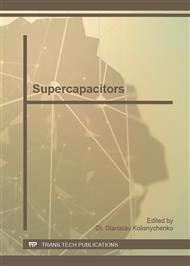[1]
M. Inagaki, Pores in carbon materials-importance of their control, New Carbon Mater. 24 (2009) 193-232.
DOI: 10.1016/s1872-5805(08)60048-7
Google Scholar
[2]
R.Q. Sun, L.B. Sun, Y. Chun, Q.H. Xu, Catalytic performance of porous carbons obtained by chemical activation, Carbon 46 (2008) 1757-1764.
DOI: 10.1016/j.carbon.2008.07.029
Google Scholar
[3]
C. Zheng, L. Qi, M. Yoshio, Cooperation of micro- and meso-porous carbon electrode materials in electric double-layer capacitors, J. Power Sources (2010) 4406-4409.
DOI: 10.1016/j.jpowsour.2010.01.041
Google Scholar
[4]
P. Kim, J.B. Joo, W. Kim, et al., A novel method for the fabrication of ordered and three dimensionally interconnected macroporous carbon with mesoporosity, Carbon 44 (2006) 389-392.
DOI: 10.1016/j.carbon.2005.08.029
Google Scholar
[5]
Y. Zhao, M.B. Zheng, J.M. Cao, et al., Easy synthesis of ordered meso/macroporous carbon monolith for use as electrode in electrochemical capacitors, Mater. Lett. 62 (2008) 548-551.
DOI: 10.1016/j.matlet.2007.06.002
Google Scholar
[6]
W. Xing, S.P. Zhuo, X.L. Gao, Preparation of hierarchical porous carbon by post activation, Mater. Lett. 63 (2009) 1311-1313.
DOI: 10.1016/j.matlet.2009.03.008
Google Scholar
[7]
G.S. Chai, I.S. Shin, J.S. Yu, Synthesis of ordered, uniform, macroporous carbons with mesoporous walls templated by aggregates of polystyrene spheres and silica particles for use as catalyst supports in direct methanol fuel cells, Adv. Mater. 16 (2004) 2057-2061.
DOI: 10.1002/adma.200400283
Google Scholar
[8]
S.W. Woo, K. Dokko, H. Nakano, et al., Preparation of three dimensionally ordered macroporous carbon with mesoporous walls for electric double-layer capacitors, J. Mater. Chem. 18 (2008) 1674-1680.
DOI: 10.1039/b717996k
Google Scholar
[9]
H. Xu, Q.M. Gao, H.L. Guo, H.L. Wang, Hierarchical porous carbon obtained using the template of NaOH-treated zeolite β and its high performance as supercapacitor, Micropor. Mesopor. Mater. 133 (2010) 106-114.
DOI: 10.1016/j.micromeso.2010.04.021
Google Scholar
[10]
B.Z. Fang, J.H. Kim, M. Kim, et al., Ordered hierarchical nanostructured carbon as a highly efficient cathode catalyst support in proton exchange membrane fuel cell, Chem. Mater. 21 (2009) 789-796.
DOI: 10.1021/cm801467y
Google Scholar
[11]
Z.Y. Wang, F. Li, N.S. Ergang, A. Stein, Effects of hierarchical architecture on electronic and mechanical properties of nanocast monolithic porous carbons and carbon-carbon nanocomposites, Chem. Mater. 18 (2006) 5543-5553.
DOI: 10.1021/cm062050u
Google Scholar
[12]
Y.H. Deng, C. Liu, T. Yu, et al., Facile synthesis of hierarchically porous carbons from dual colloidal crystal/block copolymer template approach, Chem. Mater. 19 (2007) 3271-3277.
DOI: 10.1021/cm070600y.s001
Google Scholar
[13]
C. Zou, D.C. Wu, M.Z. Li, et al., Template-free fabrication of hierarchical porous carbon by constructing carbonyl crosslinking bridges between polystyrene chains, J. Mater. Chem. 20 (2010) 731-735.
DOI: 10.1039/b917960g
Google Scholar
[14]
A.F. Gross, A.P. Nowak, Hierarchical carbon foams with independently tunable mesopore and macropore size distribution, Langmuir 26 (2010) 11378-11383.
DOI: 10.1021/la1007846
Google Scholar
[15]
S. Zhang, L. Chen, S. Zhou, D.Y. Zhao, L.M. Wu, Facile synthesis of hierarchically ordered porous carbon via in situ self-assembly of colloidal polymer and silica spheres and its use as a catalyst support, Chem. Mater. 22 (2010) 3433-3440.
DOI: 10.1021/cm1002274
Google Scholar
[16]
A.G. Loera, F. Cara, M. Dumon, J.P. Pascault, Porous epoxy thermosets obtained by a polymerization-induced phase separation process of a degradable thermoplastic polymer, Macromolecules 35 (2002) 6291-6297.
DOI: 10.1021/ma011567i
Google Scholar
[17]
S.J. Xu, J. Li, G.J. Qiao, H.J. Wang, T.J. Lu, Pore structure control of mesoporous carbon monoliths derived from mixtures of phenolic resin and ethylene glycol, Carbon 47 (2009) 2103-2111.
DOI: 10.1016/j.carbon.2009.03.069
Google Scholar
[18]
C.A. Fyfe, M.S. McKinnon, A. Rudin, Investigation of the mechanism of the thermal decomposition of cured phenolic resins by high-resolution 13C CP/MAS solid-state NMR spectroscopy, Macromolecules 16 (1983) 1216-1219.
DOI: 10.1021/ma00241a033
Google Scholar
[19]
K.S.W. Sing, D.H. Everett, R.A.W. Haul, et al., Reporing physisorption data for gas/solid systems with special preference to the determination of surface area and porosity, Pure & Appl. Chem. 57 (1985) 603-619.
DOI: 10.1351/pac198557040603
Google Scholar
[20]
N. Tsujioka, N. Ishizuka, N. Tanaka, T. Kubo, K. Hosoya, Well-controlled 3D skeletal epoxy-based monoliths obtained by polymerization induced phase separation, J. Polym. Sci., Part A: Polym. Chem. 46 (1983) 3272-3281.
DOI: 10.1002/pola.22665
Google Scholar



